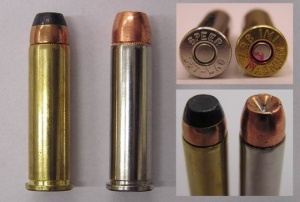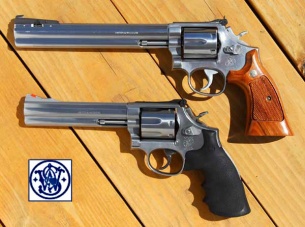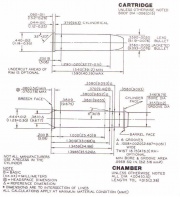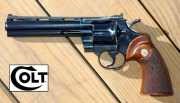.357 Magnum
| .357 Magnum | ||||||||||||||||||||||
|---|---|---|---|---|---|---|---|---|---|---|---|---|---|---|---|---|---|---|---|---|---|---|

| ||||||||||||||||||||||
| .357 Magnum ammunition | ||||||||||||||||||||||
| Type | Handgun | |||||||||||||||||||||
| Country of Origin | United States | |||||||||||||||||||||
| Specifications | ||||||||||||||||||||||
| Parent Case | .38 Special | |||||||||||||||||||||
| Case Type | Rimmed, straight | |||||||||||||||||||||
| Bullet Ø | .358 in (9.1 mm) | |||||||||||||||||||||
| Neck Ø | .379 in (9.6 mm) | |||||||||||||||||||||
| Shoulder Ø | n/a | |||||||||||||||||||||
| Base Ø | .379 in (9.6 mm) | |||||||||||||||||||||
| Rim Ø | .440 in (11.2 mm) | |||||||||||||||||||||
| Rim Thickness | .060 in (1.5 mm) | |||||||||||||||||||||
| Case Length | 1.29 in (33 mm) | |||||||||||||||||||||
| Full Length | 1.59 in (40 mm) | |||||||||||||||||||||
| Primer | Small pistol, magnum | |||||||||||||||||||||
| Production & Service | ||||||||||||||||||||||
| Designer | Elmer Keith and Phillip B. Sharpe | |||||||||||||||||||||
| Design Date | 1934 | |||||||||||||||||||||
| Manufacturer | everybody | |||||||||||||||||||||
| Ballistic Performance Sampling | ||||||||||||||||||||||
| ||||||||||||||||||||||


The .357 Magnum, also known as the .357 S&W Magnum and as the .357 Remington Magnum, is a revolver cartridge created by Elmer Keith, Phillip B. Sharpe,[3] Colonel D. B. Wesson[3] of firearms manufacturer Smith & Wesson, and Winchester,[4][5] based upon Smith & Wesson's earlier .38 Special cartridge. The .357 Magnum cartridge was introduced in 1934, and its use has since become widespread. This cartridge started the "Magnum" era of handgun ammunition.[6] In Europe, the cartridge is also known as the 9x33mmR.
Contents |
[edit] Design
The .357 Magnum was collaboratively developed over a period of time in the early to mid-1930s by a group of individuals in a direct response to Colt's .38 Super Automatic. At the time, the .38 Super was the only pistol cartridge capable of defeating automobile cover and the early body armor that was just beginning to emerge in the post-World War I "Gangster Era"[4]. Tests at the time revealed that those early ballistic vests defeated any handgun cartridge traveling at less than about 1000 ft/s. Colt's .38 Super Automatic just edged over that velocity and was able to penetrate car doors and vests that bootleggers and gangsters were employing as cover.Much credit for the .357's early development is given to hunter and experimenter Elmer Keith. Keith's early work in loading the .38 Special to increasingly higher pressure levels was made possible by the availability of heavy, target shooting-oriented revolvers like the Smith & Wesson 38/44 "Heavy Duty" and "Outdoorsman", .38-caliber revolvers built on .44-caliber frames. The .38-44 HV load, used the .38 Special cartridge loaded to a much higher velocity than standard .38 Special ammunition. The .38-44 revolvers were made by using a .44 Special size gun with the barrel and cylinder bored to .357 caliber (the true bullet diameter of the .38 Special). Since the frame, cylinder, and barrel were much stronger than the standard .38 Special components, it was capable of withstanding much higher pressures. The .38-44 HV round, while no longer available, was in most cases the equal of the later .357 Magnum, which works at more than double the pressure of standard .38 Special. The .357 Magnum addresses the safety issues earlier cartridges had by stretching the case slightly, preventing the high pressure cartridge from chambering in a firearm designed for the shorter, lower pressure version.[7] Elmer Keith also contributed the Keith-style bullet, which increased the mass of bullet located outside of the cartridge, while leaving more room inside the cartridge for powder, while also increasing the cutting power of the bullet when moving through muscle, increasing the killing effectiveness of the bullet when hunting.
In order to reassert itself as the leading law enforcement armament provider, Smith & Wesson developed the .357 Magnum, with Colonel D. B. Wesson leading the effort within Smith & Wesson, along with considerable technical assistance from Phillip B. Sharpe, a member of the Technical Division Staff of the National Rifle Association. The new round was developed from Smith & Wesson's existing .38 Special round; it used a different powder load, and ultimately the case was extended by 1/8th of an inch (0.125 in, 3.18 mm). The case extension was more a matter of safety than of necessity. Because the .38 Special and the early experimental .357 Magnum cartridges loaded by Keith were identical in physical attributes, it was possible to load an experimental .357 Magnum cartridge in a .38 Special revolver, with potentially disastrous results. Smith & Wesson's solution, of extending the case slightly, made it impossible to chamber the magnum-power round in a gun not designed for the additional pressure.[4]
The choice of bullet for the .357 Magnum cartridge varied during its development. During the development at Smith & Wesson, the original Keith bullet was modified slightly, to the form of the Sharpe bullet, which itself was based upon the Keith bullet, but which had 5/6 of the bearing surface of the Keith bullet, Keith bullets typically being made oversized and sized down. Winchester, however, upon experimenting further during the cartridge development, modified the Sharpe bullet shape slightly, while keeping the Sharpe contour of the bullet. The final choice of bullet was hence based upon the earlier Keith and Sharpe bullets, while additionally having slight differences from both.[8]
[edit] Performance
This cartridge is regarded by many as an excellent self-defense round; it still enjoys a reputation of being the gold standard of stopping power among handgun cartridges. Some of those who have used it have described a "struck by lightning" reaction in those hit with it. Some attribute this to hydrostatic shock. For big game, such as ungulates and bears (which have a substantially sturdier build than humans), it is inferior to the .44 Magnum, .454 Casull, .41 Magnum and other larger magnum rounds. Still, it is a fine small and medium game round and will kill deer very reliably at short range if the right loads (140 grain and heavier hollow-point bullets) are carefully used by a qualified marksman. [9] It has similar stopping power on game to the .45 Colt with a much flatter trajectory. It is a very versatile cartridge, and can be used with success for self-defense, plinking, hunting, or target shooting.[10]
Guns in .357 Magnum caliber have the advantage of being able to fire .38 Special ammunition, with its lower cost, recoil, noise, and muzzle flash. It has also become popular as a "dual use" cartridge in short, light rifles like the Old West lever-actions. In a rifle, the bullet will exit the barrel at about 1,800 feet per second (550 m/s), making it far more versatile than the .30 Carbine or the .32-20 Winchester. In the 1930s, it was found to be very effective on steel body armor, and metal-penetrating rounds were once popular in the United States among highway patrol and other police organizations. The .357 revolver has been largely replaced by modern, high-capacity semi-automatic pistols for police use, but is still very popular for backup gun use, and among outdoorsmen, security guards, and civilians for self-defense and hunting.
[edit] Comparisons
The .357 Magnum was a direct competitor with the .38 Super, which was designed for semi-automatic pistols. Ballistic performance for the two rounds is very similar. However since the .357 is usually chambered in revolvers, it can be shot in barrels longer than one would normally find in automatics, giving it an increase in performance.
In terms of accuracy, the .357 Magnum has at least the same potential for precision shooting as the benchmark .38 Special wadcutter round—indeed, a good .357 Magnum revolver will happily shoot .38 Special wadcutter ammunition with good results. It is this accuracy and power, and the versatility of also being capable of using less-expensive, milder .38 Special ammunition, that makes a .357 Magnum revolver an excellent gun for many different disciplines, from 20 yard (18.28 m) precision shooting to long range falling-plate events. It is an excellent round for those considering handloading ammunition, as it is economical and consistently performs well.
As mentioned above, the .357 Magnum was developed from the earlier .38 Special. This was possible because the .38 Special was originally designed to use black powder, which requires two to five times as much powder by weight to produce the same velocity with the same bullet as does the much more efficient smokeless powder. Thus the .38 Special has a relatively large case; the 9 mm Para was introduced the same year, 1902, but was originally designed for smokeless powder, and for higher pressures (~35,000 psi). It therefore produces considerably more power than the .38, despite its case having less than 1/2 the powder capacity. Most 9 mm powder charges fill the case to the base of the bullet, and some are heavily compressed. Many .38 Special loads use the same powders, in similar charge weights, but because the case is so much larger, those charges only fill the case about half full; light target loads with fast burning powders may only fill the case perhaps 1/8 full. Filling the case with slower-burning powders produces much more power, but also much more pressure—far too much pressure for older, smaller-frame revolvers chambered in .38 Special. It was to accommodate these high-pressure, high-power loads that the longer .357 Magnum, together with the stronger revolvers designed to handle it, was developed.
[edit] Factory loads
- Winchester 125 gr (8.1 g) Jacketed HP = 1450 ft/s (440 m/s), 583 ft·lbf (790 J)
- Winchester 158 gr (10.2 g) Jacketed HP = 1235 ft/s (375 m/s), 535 ft·lbf (725 J)
[edit] Synonyms
- .357
- 357
- .357 Mag
- .357 Remington Magnum
- .357 S&W Magnum
- .357 Mangle'em (slang)
- 9x33mmR (European designation)
[edit] See also
- .357 SuperMag
- .357 Remington Maximum
- 9 mm Luger Parabellum
- .357 SIG
- Colt Python
- Desert Eagle
- Ruger GP-100
- Smith & Wesson Model 19
- Smith & Wesson Model 27
- Smith & Wesson Model 686
- List of handgun cartridges
- 9 mm caliber Other cartridges of similar size
- Hydrostatic shock
[edit] References
- ↑ Federal Cartridge Co. ballistics page
- ↑ DoubleTap Ammunition
- ↑ 3.0 3.1 Sharpe, Phillip B. (1937). Complete Guide to Handloading, 405-406.
- ↑ 4.0 4.1 4.2 " The 20th Century's Top Handgun Cartridges" by Dick Metcalf in Shooting Times February, 2000
- ↑ Barnes, Frank C. [1965] (2006). in Skinner, Stan: Cartridges of the World, 11th Edition, Iola, WI, USA: Gun Digest Books, 299. ISBN 0-89689-297-2.
- ↑ "The .357 Magnum" by Chuck Hawks
- ↑ .38-44 HV: The Original Magnum - revolver round
- ↑ Sharpe, Phillip B. (1937). Complete Guide to Handloading, 293-294.
- ↑ "The Three-Fifty-Seven Magnum's in My Life" by Jim Taylor at Leverguns.com
- ↑ "The Versatile .357 Magnum" by Chuck Hawks (subscription required)
[edit] External links
- Coonan pistol - semi-automatic pistol in .357 Magnum
- .357 Magnum Videos


